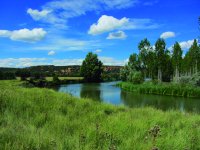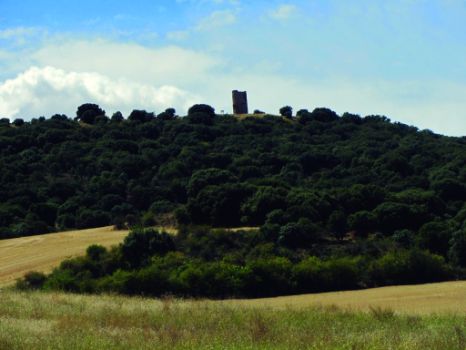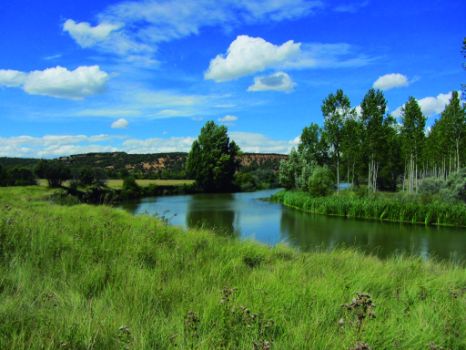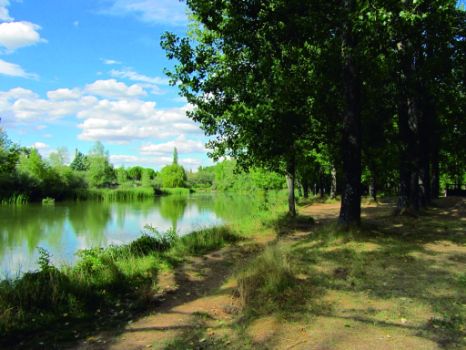Net of Natural
Trails

Stage 4: Ituero - Almazán
Description
Through Tierras de Almazán
Green pine forests are a natural feature of Tierras de Almazán County, which has a long history of resin production. Pinewoods alternate with fields of grain which change colour with every season. In autumn and winter, the field has rich brown hues; in spring it turns green; and in summer, the August heat turns the wheat and barley a golden yellow.
The Stage runs along a road with little traffic from Cubo de la Solana to Ituero. The route veers onto the first path that emerges on the left, and continues up a gentle slope to Alto del Pecho, where few small maritime pinewoods (Pinus pinaster) stand.

The route continues along an easy path through plains covered with grain. The ruins of a few pens, and maritime pine and English poplar (Populus nigra) forests around small springs bring a touch of colour to the landscape.
Further on, the Trail traverses through a maritime pine forest, and turns to the right (west). In the background, one can feel the presence of the River Duero, easily recognizable by the perfectly aligned trees of its riparian forest.
The route reaches the road linking Cubo de la Solana with Almazán, along which it continues for over 1.5 kilometres. It now turn left towards a bridge on a River Duero meander, from where one can enjoy a nice view of river flanked by riparian vegetation. Farmed poplars used for manufacturing paper, fruit crates, stakes and toothpicks are also grown here.
Further on, the route passes over Almazán Canal, which carries water used to irrigate much of the land on the left bank of the River Duero, as it traverses through the namesake town.

It now turns right onto the first path with a view of Torrejalba, where the remains of a Muslim watchtower stand. It was used to watch over the Duero Valley, a territory that for many years was the border between the Christian and Muslim kingdoms.
Further on is a large poplar forest where sheep and goats graze in the shade on hot days. Under the watchful eye of Torrejalba's lookout tower, the route continues along Almazán Canal, on the hillside covered with holm oaks and pines. The route ventures into a closed valley through which the Duero forges ahead, through a landscape in which farmsteads alternate with vast Mediterranean forests.
A bridge over Almazán Canal drives the route closer to the River Duero, until the two come together at a meander, offering a beautiful snapshot.
The Trail arrives at Valdespina, a small town nestled in the slopes covered with trees. From here, and for almost 6 kilometres, the route runs along the road to Viana de Duero. At first, the road winds up through holm oaks (Quercus ilex), maritime pines and Pyrenean oaks (Quercus pyrenaica) to the top of the hill. A long, straight road across the plateau leads to Viana de Duero. One can see two towers or watchtowers on the horizon, located atop two hills that loom above the surrounding territory.

Past the hamlet of Viana de Duero, which the route skirts around, the Trail continues along a path on the right that passes next to Las Adobares Fountain, amidst reeds that thrive on the moist environment. This paved farm road traverses through farmland and pine-oak woods towards Almazán. However, it first makes a short detour to the small town of Baniel, which is practically abandoned.
The last stretch before reaching Almazán runs amidst farmsteads, and past a pig slurry cogeneration plant.
The route reaches the regional road CL-101, and continues to an interStage where it takes the exit to Almazán. Caution should be exercised when travelling along this road leading to an industrial park as it carries motorised traffic. A sign indicates that the route continues along a quiet street.
The route ventures into Almazán from the north until Parque de las Islas on the banks of the River Duero. Charming swans and a large flock of mallards can be seen swimming in the park's artificial lake.
The pleasant walk leads to the 12th century, medieval masonry bridge in the centre of the town. From here, it continues along the same side of the river, occasionally peeking up at the wall that used to enclose the town, until it reaches the endpoint of this Stage next to La Arboleda Park, a wonderful place to rest.
Sites of interest
Puntos de interés
Hostel
Passport
Profile

Highlights
Further information
Sheep
This county has a long-standing relationship with sheep, especially during the times of the Mesta.
The "ojalada" or Sorian "Churra" sheep, which owes its name to the colour of the circle around its eyes, has black-tipped ears and nose. This hardy breed has been grown in many regions for its adaptability to harsh conditions. However, today it is an endangered species that has been replaced by other breeds.
Meat production is the main purpose for breeding this sheep, protected under the "Lechazo de Castilla y León" Protected Geographical Indication (PGI). It addition to producing large amounts of milk, this breed makes excellent mothers and do a good job raising lambs, despite the difficult living conditions.





